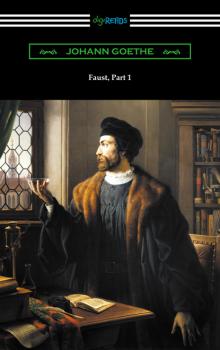Johann Goethe
Список книг автора Johann GoetheFaust
Johann Wolfgang von Goethes »Faust« (1808) ist und bleibt das bekannteste Werk der deutschen Literatur. Zu den begeisterten Lesern gehörte auch der französische Maler Eugène Delacroix (1798–1863). Angeregt von einer Aufführung des Dramas, schuf Delacroix 1828 einen eigenständigen Bildzyklus zum »Faust«. Seine Lithographien zählen längst zu den Klassikern der Buchillustration. Es handelt sich um insgesamt 17 Bilder zu den Schlüsselszenen des Stücks. Die Lithographien wirken mit ihrer subtilen Hell-Dunkel-Zeichnung wie kleine Gemälde mit feinsten Tonabstufungen und unterschiedlichen Schattierungen. Besonders die Mephistoteles-Szenen besitzen eine fast fantastische Anmutung. Andere Szenen erinnern an die romantischen Bildkompositionen von Delacroix' Malerei. Die Illustrationen sind als individuelle künstlerische Auseinandersetzung mit dem Dramentexte zu werten. Das Werk wurde ein Bestseller, von dem nicht nur Goethe selbst begeistert war. Diese Neuausgabe bietet die Illustrationen von Delacroix mit dem deutschen Originaltext und einer kunsthistorischen Einführung dar.
Elective Affinities
German writer Johann Goethe's novella «Elective Affinities» is a singular book which attracts both creative minds and pragmatic minds. Romantics at heart will be drawn to the convoluted love affair; married couple Eduard and Charlotte invite two close friends to live with them on their idyllic estate for a short time. The innocent invitation takes an unexpected turn though, as each of the spouses become attracted to their guests. Eduard falls in love with Ottilie, the young and attractive niece of Charlotte, and Charlotte finds herself drawn to Captain, the down-on-his-luck friend of Eduard. What draws science-minded readers to the story is Goethe's theory of elective affinities, or the relationship between certain compounds which means that they only react with each other under very unique circumstances. Goethe draws comparisons of science with sociology, allowing his characters to act and react with each other based on the elective affinity principle. The characters pairing up under the circumstances of their living condition creates a passionate, secretive environment that causes each person to reconsider their own morals. They want love, but how far are they willing to go to obtain it? Goethe pits two opposing ideas against each other: that people are slave to their desires and their own agents of free will. It is a dichotomy that has captivated audiences to return to «Elective Affinities» for over two-hundred years.
The Sorrows of Young Werther (translated by R. D. Boylan)
First published in 1774, “The Sorrows of Young Werther” is the loosely autobiographical epistolary novel by German author Johann Wolfgang von Goethe. This classically tragic story is one of unrequited love. During a stay in the fictional village of Wahlheim, Werther becomes enamored with the simple ways of the peasantry there. He meets and falls in love with the beautiful young Lotte, despite her engagement to Albert. The highly emotional Werther is overcome with grief over the fact that the one that he loves will marry another. Despite this fact, he develops a friendship with the couple over the next few months. Eventually his pain becomes so great that he must take his leave. After a time he returns, but seeing the couple now married brings his grief to an extreme that he can no longer bare, which leads to the novel’s epically tragic conclusion. Cited as a major work from the “Sturm und Drang” period of German literature, which would be highly influential of the Romantic period to come, “The Sorrows of Young Werther” was Goethe’s most famous work during his lifetime, one which would bring him instant international fame. This edition follows the translation of R. D. Boylan and includes a biographical afterword.
Faust, Part 1 (Translated by Anna Swanwick with an Introduction by F. H. Hedge)
Considered by many as Johann Goethe’s magnum opus, “Faust” has a peculiar history of composition and publication. What began as a project in Goethe’s youth, at the age of twenty, in 1769, “Faust” would not fully be completed until 1831 very near the end of the author’s life. Based on the German legend of Johann Georg Faust, a magician of the German Renaissance who reportedly gained his mystical powers by selling his immortal soul to the devil, the Faustian legend has forever come to symbolize the inherent peril in dealing with unscrupulous characters and supernatural forces. Presented here in this volume is the first part of “Faust”, which begins with a prologue in heaven in which we find god challenging the devil that he cannot lead astray one of his favorite scholars, Dr. Faust. The devil, known in the play as Mephistopheles, accepts the challenge and so begins the struggle of Faust between the allure of supernatural power and the fate of his soul. Despite numerous adaptations, Goethe’s “Faust” stands out as arguably the most famous version of this legend. Only Christopher Marlowe’s “Dr. Faustus” can be claimed to rival it for that position. This edition is translated by Anna Swanwick, includes an introduction by F. H. Hedge, and a biographical afterword.
Faust, Part 1
The Faustian legend has captured the imagination of readers and writers for centuries and in Goethe's «Faust» we find one of the greatest tellings of this old German tale. It is the story of man who makes a deal with the devil and pays with his soul. The influence of this theme on literature cannot be understated. In Goethe's «Faust» we find what is probably the most famous version of the story and one of the greatest works of literature ever written.
The Sorrows of Young Werther
"The Sorrows of Young Werther" is the 1774 epistolary novel by Johann Goethe. A loosely autobiographical novel, «The Sorrows of Young Werther» tells the story of its title character, an artist with a highly sensitive and passionate temperament who falls in love with Lotte, a beautiful young girl who is promised to another in the fictional village of Wahlheim. A classic and tragic love story, «The Sorrows of Young Werther» established Goethe as an international literary celebrity and heavily influenced later Romantic works.






